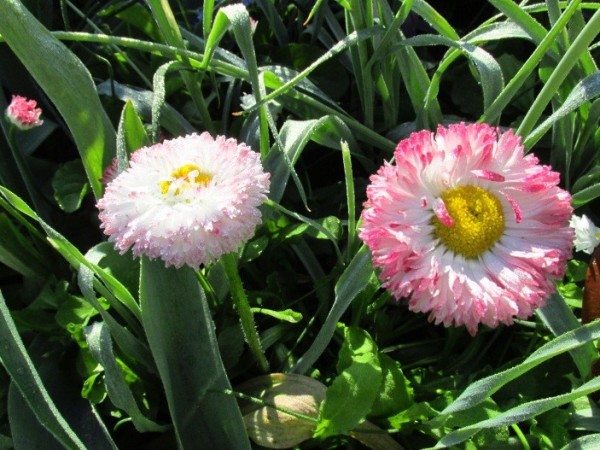 In October and November, seasonal flower beds change from summer annuals to winter-hardy annuals which are over-planted above tulips. In the spring, the effect is one of a multi-layered composition with tulips blooming above a groundcover of hardy annuals.
In October and November, seasonal flower beds change from summer annuals to winter-hardy annuals which are over-planted above tulips. In the spring, the effect is one of a multi-layered composition with tulips blooming above a groundcover of hardy annuals.
This part of the South is lucky to have winter months mild enough to allow some annuals, such as English daisy (Bellis perennis) and pansy varieties (Viola spp.), to survive the winter, and in many cases bloom throughout the winter.

English Daisy
The pomegranates (Punica granatum) are fruiting in the small meadow to the east of the colonial nursery and are approaching maturity.
The >(Arbutus unedo) are making their last dash to red from green as the fall begins to cool. Ask to see the Indian currant (Symphoricarpus orbiculatus), the artichokes and cardoons (Cynara scolymus & C. cardunculus), huge, edible thistle-like vegetables.
Artichokes ready for harvest
The purple berries on the American beauty berry (Callicarpa americana) are making a great show now and should hang on well into October. By the middle of November, the Giant Sunflower (Helianthus giganteus) will be in bloom and often lasts into the first of December.
Adjacent to the Colonial Nursery, on Palace Green, take some time to notice the catalpa tree (Catalpa bignonioides) seedpods which become more obvious as the bright gold leaves begin to fall. The catalpa trees are a documented fixture in Williamsburg, having been noted by Thomas Jefferson.
On Market Square, the evergreen majesty of the Compton Oak (Quercus comptoniae) becomes more apparent as deciduous trees drop their leaves. At the Peter Hay Shop on Nicholson Street, the tall Horse Chestnut (Aesculus hippocastaneum) tucked into the ravine is showing its seed clusters.
The Governor’s Palace is always a tremendous undertaking when planting the seasonal floral displays. The annual beds at the rear of the ballroom garden cumulatively take over 2,000 annuals.
The perennial beds, which surround the large annual beds, will be planted basket-of-gold (aurinia saxatilis), cottage pinks (Dianthus plumarius) and foxgloves (Digitalis purpurea), which give the perennial beds an early spring advantage while the traditional perennials catch up with the warmer weather.
Leave a Reply